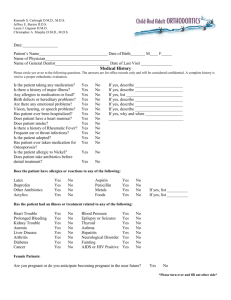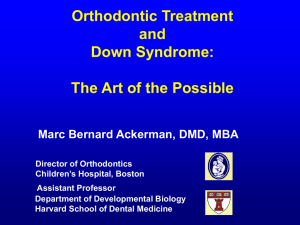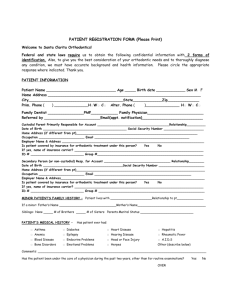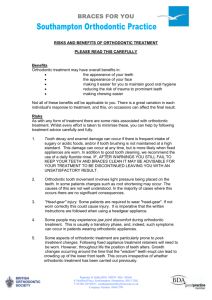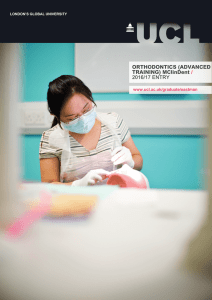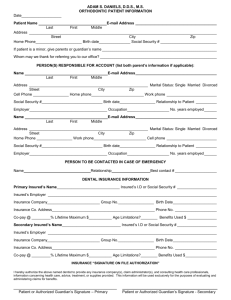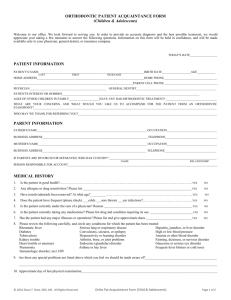tips on filing invisalign insurance claims
advertisement
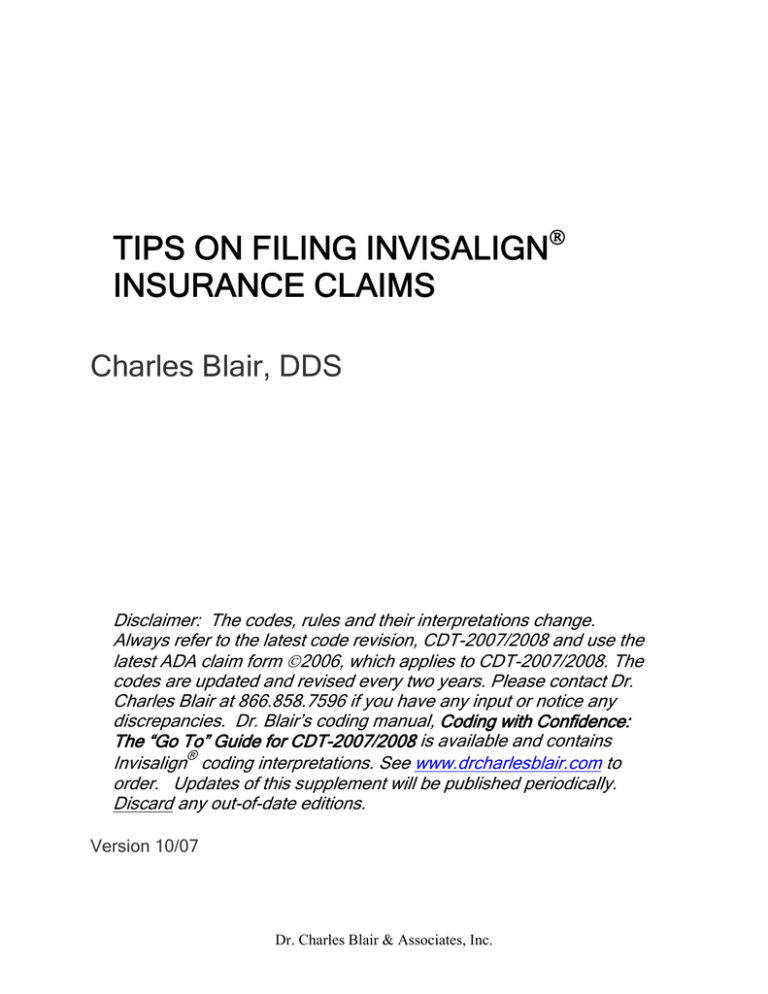
TIPS ON FILING INVISALIGN! INSURANCE CLAIMS Charles Blair, DDS Disclaimer: The codes, rules and their interpretations change. Always refer to the latest code revision, CDT-2007/2008 and use the latest ADA claim form "2006, which applies to CDT-2007/2008. The codes are updated and revised every two years. Please contact Dr. Charles Blair at 866.858.7596 if you have any input or notice any discrepancies. Dr. Blair’s coding manual, Coding with Confidence: The “Go To” Guide for CDT-2007/2008 is available and contains ® Invisalign coding interpretations. See www.drcharlesblair.com to order. Updates of this supplement will be published periodically. Discard any out-of-date editions. Version 10/07 Dr. Charles Blair & Associates, Inc. Table of Contents Introduction Page 3 General Considerations Page 3 Determining Eligibility Page 4 Completing the Insurance Claim Form Pages 5-8 ! Patient Information Section ! Billing Dentist Section ! Coding Description of Invisalign® Services ! Pre-Orthodontic Treatment Visit ! Records Visit Claim ! Initial Orthodontic Treatment Start Claim ! Periodic Ortho Treatment Visit Claim ! Retention Claim Insurance Claim Summary Pages 9-10 Insurance Call Reference Guide Pages 11-12 Typical Invisalign® Q & A’s Pages 13-18 2 ©2007 Dr. Charles Blair & Associates, Inc. Introduction The following insurance information is not intended to provide complete instruction on submitting insurance claims, but rather provide supplemental information that may help the non-orthodontic office better incorporate orthodontic services into their practice. General Overview The following information is provided to give you a quick summary of the process of filing insurance claims for orthodontic services. Eligibility • • • • Orthodontic treatment is based on the dentition and scope of treatment (rather than the specific appliance or technique). Generally Invisalign® should be covered under dental insurance plans that offer orthodontic coverage to the same extent as other orthodontic treatment appliances or techniques. ALWAYS contact the patient’s insurance carrier to determine eligibility and coverage. Use the ‘Insurance Call Reference Guide’ at the back of this guide to collect information on the patient’s coverage prior to financial discussion. If your claim is rejected, review the most recent CDT codes (currently CDT-2007/2008), carrier guidelines and this document to verify proper coding. The vast majority of claim rejections are based on improper coding or incomplete documentation. The insurance information in this supplement has been provided by Charles Blair, DDS of Dr. Charles Blair & Associates, Inc. Dr. Blair is an expert in coding, financing and practice management matters regarding Invisalign®. For information regarding Dr. Blair’s Revenue Enhancement Program Call 866.858.7596 or visit www.drcharlesblair.com. One-on-One Coaching program is available by telephone and provides fee, insurance coding, clinical protocol and patient financing direction for dentists. Records Appointment • Records fees (if filed separately) may or may not be counted against the orthodontic lifetime maximum. • An advantage of filing records separately is to see how the insurance company handles the record claim forms prior to active treatment. Also, cash flow is faster. Submission • Do not send diagnostic casts, oral images, or x-rays unless requested (generally not required). • Make sure claims are clean and accurate and are submitted with the correct documentation. Never submit general dentistry treatment with orthodontic treatment on the same claim form. • Retention is often included as part of the orthodontic case fee and not billed separately, except for replacement retainers, which are generally the patient’s responsibility. Reimbursement • Normally spread over the course of treatment • Some carriers pay automatically, while others require a monthly (or other interval) claim form. An annual deductible may apply. 3 ©2007 Dr. Charles Blair & Associates, Inc. 1st Step --- Determining Eligibility The biggest difference between processing claims for orthodontic treatment and claims for general dental procedures is how benefit payments are broken down and dispersed across the course of treatment. This is managed differently from insurance company to insurance company, with many insurance carriers paying benefits automatically at regular intervals, after the initial claim is filed. Others require monthly, quarterly, or other filing interval claims during the active treatment duration. Dependent high school and college students are often eligible for orthodontic benefits. Approximately 15% of adults with dental insurance are eligible for orthodontic benefits. Orthodontic benefits differ significantly from policy to policy; ALWAYS contact the patient’s insurance carrier to determine eligibility and coverage. Use the Orthodontic Insurance Call Reference Guide (see page 10) to collect information on key eligibility questions. By checking the eligibility or benefit information prior to the patient’s evaluation or consultation, your practice is not only set up to provide a more organized consultation, but it helps your patient more easily and quickly evaluate the financial options available. You can simply place a copy of the form in the patient’s file. 2nd Step --- Complete the Insurance Claim Form The following information provides a general overview of how to properly complete an orthodontic claim form. These forms do differ from restorative and preventative claims. If you have more detailed questions or want more extensive one-on-one training, this is covered in Dr. Blair’s consulting program that provides extensive support for Invisalign® dentists in all practice management areas. Now available is Coding with Confidence: The “Go To” Guide for CDT-2007/2008, by Charles Blair, DDS. For further information, call 866.858.7596 or go to www.drcharlesblair.com for information. Claim Form Information Section: Make sure all required information is completed in the top section of the insurance form. Ancillary Claim/Treatment Information Section: Provide all the required information. Make sure to check the box (“yes”) that asks “Is treatment for orthodontics?” on each orthodontic claim. Initial Appliance Placement: If the visit is the initial appliance placement (appliances placed), indicate the “date appliance placed,” and “months of treatment remaining” in the appropriate boxes. You will generally not be required to submit radiographs, oral images, or diagnostic models so that “00” would be entered in each of these boxes. Periodic Treatment Appointments: If the visit is the periodic treatment appointment and a form is required for reimbursement, then enter the “date appliance placed,” and “months of treatment remaining” in the appropriate box. Retention Appointments: If retention is reported separately then enter the “date appliance placed,” and “months of treatment remaining” in the appropriate boxes. In submitting the retention claim form, active orthodontic treatment is complete so “0” will be entered in the “months of treatment remaining” box. 4 ©2007 Dr. Charles Blair & Associates, Inc. Description of Invisalign® Services The following treatment codes are suggested for the various phases of treatment: I. Pre-Orthodontic Treatment Visit (D8660) is typically reported for a growth and development checkup, prior to taking orthodontic records and active treatment. This is considered a pre-orthodontic visit. In the general practitioner setting, often the Invisalign® candidate is seen at the regular periodic evaluation visit. In some cases the general dentist will use the Case Presentation (D9450) procedure code for the Invisalign® treatment presentation. Generally, there is no charge for the Pre-Orthodontic Treatment Visit (D8660) or Case Presentation (D9450) and one is not necessarily recommended. The vast majority of orthodontists do not charge for the Pre-Orthodontic Treatment Visit (D8660), which is generally complimentary. However, taking orthodontic records is generally charged at a subsequent visit by both orthodontists and general dentist. In the “Record of Services Provided” section of the claim form enter the following procedures: Date mm/dd/yy ADA Code D8660 mm/dd/yy D9450 Procedure Pre-Orthodontic Treatment Visit Or Case Presentation Fee $$ $$ In the “Ancillary Claim/Treatment Information Section” of the claim form, confirm the following entry: Is treatment for orthodontics? Check the block (#40) “yes.” II. Records Visit Reporting There is not a specific “orthodontic records” code. A records visit may typically include panoramic film (D0330) (or full series (D0210)), oral/facial images (D0350) and diagnostic casts (D0470) procedures. For Invisalign®, a cephalometric x-ray (D0340) is not required. Any records procedures performed (photos, casts, pan/full series) on the records date may be paid out of either general dental benefits or orthodontic benefits, if available, depending on the funding provisions of the policy. If the records reimbursement is applied against orthodontic benefits, this will often reduce the lifetime ortho benefit amount accordingly. Notes: # # A recent panoramic film (D0330) or full series (D0210) may have already been taken at the patient’s routine evaluation visit (paid out of the general dental benefits). If so, these recent x-ray procedures may not be required to be taken on the orthodontic records date. Some dentists do not report a separate records fee, but an all-inclusive case treatment fee. However, it helps cash flow to file for records when initially taken. The second advantage is to see if the claim is paid as expected, prior to active treatment. This is an early warning. If the records are paid; probably the case fee will be paid. The third advantage is that the records fee in some instances is funded separately, in addition to the orthodontic lifetime maximum. 5 ©2007 Dr. Charles Blair & Associates, Inc. In the “Record of Services Provided” section of the claim form enter the following procedures, as applicable: Date mm/dd/yy mm/dd/yy mm/dd/yy ADA Code D0470 D0350 D0330 mm/dd/yy D0210 Procedure Diagnostic Casts Oral Images Panoramic Film Or Full Series Fee $$$ $$$ $$$ $$$ In the Ancillary Claim/Treatment Information Section of the claim form, confirm the following entries: 1. Number of radiographs, oral images, or casts enclosed? Enter “00” in each block (#39) 2. Is treatment for orthodontics? Check the block (#40) “Yes” *Generally sending records is not required. Submit only if requested. III. Treatment Start Visit (Active Appliance Placement) Directly in the “Records of Services Provided” section of the claim form, document the information as listed. This may be done in long hand, typed, or through a computerized billing system as there is not a specific section labeled for some of this information: # # # # Total case Fee: $$$ Patient’s Down Payment: $$$ Monthly Payment Terms: $$$ Case Classification – D8030 Limited orthodontic treatment of the Adolescent dentition* or " D8040 Limited orthodontic treatment of the Adult dentition** " D8080 Comprehensive orthodontic treatment of the Adolescent dentition* or " D8090 Comprehensive orthodontic treatment of the Adult dentition. ** Code 8090 is for a complete case (upper and lower arches) while 8040 is limited treatment (not treating both arches fully). # Case Diagnosis - Angle Class I, II, III malocclusion # Other Documentation as required by Carrier: other information as required " *Adolescent dentition indicates permanent dentition, but growth is not complete. **Adult dentition indicates permanent dentition and growth is complete. 6 ©2007 Dr. Charles Blair & Associates, Inc. In the “Ancillary Claim/Treatment Information Section” of the claim form, confirm the following entries: 1. Is treatment for orthodontics? 2. Date appliances placed (#41) 3. Months of treatment remaining** Check the block (#40) “Yes” mm/dd/yy (Start date of active appliances) – today’s date [ X ] (Months remaining for active treatment (#42) *Enter total estimated months of active treatment. This number will decrease with each subsequent claim form submitted after the case start date, if the third- party requires a monthly or quarterly claim form. IV. Periodic Orthodontic Treatment Visit (as part of contract) (D8670) Some plans require a monthly or quarterly claim for payment. In the “Record of Services Provided” area of the claim form, enter the following: Date ADA Code Procedure Fee mm/dd/yy D8670 Periodic Orthodontic Treatment Visit $$$ In the “Ancillary Claim/Treatment Information Section” of the claim form, confirm the following entries: 1. Treatment for orthodontics? Check the block (#40) “Yes” 2. Date appliances placed (#41) mm/dd/yy (Start date of active appliances) 3. Months of treatment remaining [ X ]* (Months remaining for active treatment (#42) *This number will decrease with each claim form submitted after the case start date, if the payer requires a monthly or quarterly claim form for payment. 7 ©2007 Dr. Charles Blair & Associates, Inc. V. Orthodontic Retention Visit (Retainers placed after active treatment phase) -(D8680) If a separate “retention” fee is reported at the end of active treatment, in the “Record of Services Provided” area of the claim form, enter the following: Date ADA Code Procedure Fee mm/dd/yy D8680 Orthodontic Retention $$$ In the “Ancillary Claim/Treatment Information Section” of the claim form, confirm the following entries: 1. Treatment for orthodontics? Check the block (#40) “Yes” 2. Date appliances placed (#41) mm/dd/yy (Start date of active appliances) 3. Months of treatment remaining [ X ]* (Months remaining for active treatment (#42) * In the “months remaining” box, “zero” should be entered as active treatment is completed, and the retainer is placed. 8 ©2007 Dr. Charles Blair & Associates, Inc. Summary A summary of entries for Invisalign® related services is provided in the following table. The current claim form is ADA "2006, which applies to CDT-2007/2008: ADA1 2006 # PRE-ORTHODONTIC TREATMENT VISIT CLAIM FORM Procedure code – Pre-Orthodontic Evaluation Is Treatment for Orthodontics? RECORDS VISIT CLAIM FORM Procedure code – oral/facial images Procedure code – diagnostic casts Procedure code – panoramic film Procedure code – full series Procedure code – oral/facial images Radiographs, oral images or models enclosed / Number of Enclosures Is Treatment for Orthodontics? Date appliance placed Months of treatment remaining ACTIVE TREATMENT START CLAIM FORM Procedure code – Invisalign® Anterior Case Limited Ortho – Adolescent or Limited Ortho - Adult Procedure code – Invisalign® Full Case Comprehensive Ortho – Adolescent or Comprehensive Ortho - Adult Radiographs, oral images or models enclosed/Number of Enclosures Is Treatment for Orthodontics? Date appliance placed Total months remaining2 Under the “Record of Services Provided” section of the form, include the following in the description box next to the procedure code entered (you can write it long-hand, typed or via computerized system): Estimated length of treatment Total Case Fee Patient’s down payment Monthly payment terms2 Case Diagnosis 29 40 29 29 29 29 29 39 40 41 42 29 29 39 40 41 42 D8660 Check ‘‘yes’’ Block D0350 D0470 D0330 D0210 D0350 Enter “00’’ in each Block Check ‘‘yes’’ Block Leave blank Leave blank D8030 or D8040 D8080 or D8090 Enter “00’’ in each Block Check ‘‘yes’’ Block Enter “mm/dd/yy” Enter “# months remaining” ‘est. # months’ ‘$X,XXX’ ‘$X,XXX’ ‘$XXX’ Angle Class I, II, III malocclusion Other documentation as required by carrier 1 2 Copyright 2006 American Dental Association If using Third-Party Finance or Payment In-Full and the patient has no monthly payments, write $0, but note that the patient has paid his/her co-payment amount. 9 ©2007 Dr. Charles Blair & Associates, Inc. SUMMARY (continued) ADA 2006 # 29 39 40 41 42 29 39 40 41 42 PERIODIC ORTHODONTIC TREATMENT VISIT CLAIM FORM Procedure code – Periodic orthodontic treatment visit Radiographs, oral images or models enclosed / Number of Enclosures Is Treatment for Orthodontics? Date appliance placed Months of treatment remaining ORTHODONTIC RETENTION CLAIM FORM (after active appliance) Procedure code – Orthodontic Retention Radiographs, oral images or models enclosed / number of enclosures Is treatment for orthodontics? Date appliance placed Months of treatment remaining 10 ©2007 Dr. Charles Blair & Associates, Inc. D8670 Enter “00” in each block Check ‘yes’ Block Enter “mm/dd/yy” Enter “# months remaining” D8680 Enter “00” in each block Check ‘yes’ block Enter “mm/dd/yy” Enter “# months remaining” ORTHODONTIC INSURANCE - CALL REFERENCE GUIDE Patient Name _________________________________ Date: ____________________________________ Insurance Company ____________________________________ 1. Who is eligible under the plan? # Self # Spouse # Dependent # Student 2. Is the patient covered for Adult or Adolescent Orthodontic coverage? ____________________________________ If patient is covered, answer the following: a. Up to what age is patient (self, spouse, dependent, student) covered? b. What is the orthodontic dental plan benefit amount? (typically $1,500-$2,500 lifetime for ortho) c. Has the patient had previous claims against their orthodontic lifetime maximum? If so, what amount? d. Is there a specific waiting period for orthodontic benefits? If so, what waiting period? e. Is the orthodontic coverage benefit totally independent from the general dental benefit or coordinated? _____________________________________ _____________________________________ # Yes # No ____________________________________ # Yes # No _____________________________________ # Yes # No ____________________________________ If orthodontic benefits are coordinated with general dental benefits – how and at what limits? 11 ©2007 Dr. Charles Blair & Associates, Inc. f. Does the plan require treatment by an in-network PPO/HMO plan dentist for orthodontic benefit coverage? If the dentist is out of network, is there a reduction in the fee paid, if any? Amount to be paid? g. If the dentist is a member of the orthodontic patient’s network carrier, does the plan control the maximum fee that the dentist may charge by contract, even though there is no coverage by the plan? # Yes # No ____________________________________ # Yes # No # Yes # No Or can the dentist charge full fee and the patients pays the balance? i. Is additional documentation required on the case start claim form? If so, what is required? j. Are benefits paid automatically after the initial claim for active treatment? # Yes # No _____________________________________ # Yes # No # Monthly # Quarterly # Other If not, what are the intervals that periodic claims must be filed? 12 ©2007 Dr. Charles Blair & Associates, Inc. ® Invisalign Q & A’s 1. Who is covered for an orthodontic benefit? Generally, there must be an orthodontic rider purchased by the employer f or coverage. If so, # Generally a dependent up to age 19. # Generally a dependent up to ages 23-25, if a full-time student # Adults are occasionally benefited under the orthodontic rider. 2. Is Invisalign® treated differently from regular orthodontics with respect to the procedure codes utilized? No, the same CDT-2007/2008 codes are utilized for all types of orthodontic treatment. 3. Is Invisalign® treated differently from regular orthodontics with respect to reimbursement? Generally, there is no difference in reimbursement, if benefited. There are a few exceptions. 4. What is the typical orthodontic lifetime limit and coverage? # # # # The most common orthodontic lifetime limit is $1,500. Some policies have a lower limit of $1,000 and a few pay as high as $2,500 or more. Benefits are typically paid at 50%. Some have a recurring annual deductible ($50 - $150) during the course of treatment. The typical coverage of a lifetime $1,500 benefit is generally all-inclusive (includes records, active treatment and retention). It may also include orthodontic-related procedures such as extractions, fiberotomies, frenectomies, miscellaneous orthorelated perio procedures, and surgical access to the unerupted tooth. These orthodontically-related procedures may not generally be covered under regular dental benefits and the claim form should indicate they are “orthodontic-related procedures.” Thus the claim form question, “Is treatment for orthodontics?” is checked “yes” in the appropriate block. However, if the orthodontically-related benefits are paid out of general dental benefits, often the UCR is paid at 50% rather than 80%. The orthodontic lifetime limit is often in addition to the regular dental benefit limit for the vast majority of plans. In some cases, the maximum annual limit is fixed at $1,500 for both orthodontic and regular dental coverage in the same year. Thus, if the regular dental benefit is used, then the orthodontic benefit may be reduced dollar-for-dollar for that treatment period. In other cases, a maximum (for instance $1,500) is stated but only a portion is available for orthodontic reimbursement, even if the general dentistry portion is not used. For instance, the ortho benefit is limited to $500 of the $1,500 total benefit. With so much variability of benefits, a call to determine eligibility and benefit coverage is a must for each case! 5. Do annual deductibles apply to orthodontic benefits? Some polices have recurring annual deductibles of $50-$150. Be sure this is one of the questions to ask when the call is made to check the patient’s eligibility. 13 ©2007 Dr. Charles Blair & Associates, Inc. 6. Should I predetermine orthodontic coverage? Always. Call and verify eligibility, deductibles, exclusions, limitations, lifetime maximum benefit, and any orthodontic benefit already used. Also determine if dental and orthodontic coverage are coordinated with an upper limit (maximum) for both. This is a trap, as any dental benefit used during the year may reduce the orthodontic benefit dollarfor-dollar. In some other cases, a maximum (for instance $1,500) is stated, but only a part is available even if the general dentistry portion is not used. For instance, the ortho benefit is limited to $500 out of a total $1,500 benefit. Fortunately this is not common. 7. How do I handle secondary coverage for orthodontics? Only accept primary coverage, never secondary. Secondary is totally unpredictable. Set up your financial arrangements solely based on the primary coverage. Any secondary coverage, if any, goes directly to the patient. 8. Are there any maximum orthodontic fee limitations? A. No, if the dentist does not participate in any third-party contracted plan. B. Yes, if the dentist is a provider for a PPO/capitation plan with an orthodontic benefit which sets, by contract, the maximum fee that may be charged for an orthodontic case. The PPO/capitation plan will pay up to their lifetime maximum while simultaneously controlling the out-of-pocket paid by the patient. Thus, the total fee is limited. C. Yes, if the dentist participates in a plan which by contract sets the maximum orthodontic fee that may be charged the patient – even though the plan pays no orthodontic benefit. This is the “worst of the worst.” These plans brag about the great benefits for the patient even though they pay no reimbursement. Note: It is worth a call to the third-party carrier in regards to their orthodontic fee limitation. Some carriers require you to submit an orthodontic fee schedule and will only reimburse up to that amount. Although you are ‘allowed’ under some contracts to charge the patient more for “aesthetic” orthodontic options such as Invisalign® or lingual brackets, it may be possible to list the ‘premium’ by using the code D8999. This approach may allow you to charge the patient the difference. The D8999 code and fee must clearly be listed separately in the treatment plan presentation and the patient must agree in writing. 9. I am a participating member of XYZ Insurance Company. They pay no orthodontic benefits but list a “table of procedures” with maximum fees for various procedures. My orthodontic fee is $4,850 and they list $3,700 for an adult full-case fee on their table of procedures. Do I have to discount my fee under their contract? Yes, your contract calls for you to provide the service for $3,700, even though the insurance carrier does not pay any benefit toward treatment. This is a “bonus” to the patient/employer and limits your fee since you are a participant. However, it’s worth a call to the carrier and see if there is a work-around. They may permit you to bill separately for the “aesthetic premium” to be coded as D8999. Provided, of course that the patient agrees in writing and the “aesthetic option” charge is listed on the treatment plan. 10. My Invisalign® fee is $4,800. I offered a 7% cash bookkeeping adjustment to the patient and they accepted. What fee amount goes on the insurance claim form The latest ADA insurance claim form (©2006) has the following statement on the bottom of the form: “I hereby certify that the procedures as indicated by date are in progress (for procedures that require multiple visits) or have been completed. The $4,800 fee as 14 ©2007 Dr. Charles Blair & Associates, Inc. discounted by 7% to the patient for cash is $4,464. $4,464 is to be entered on the insurance claim form as the total fee, which the patient is obligated to pay. If intentional, it could be fraud to enter $4,800 as the case fee when the patient actually paid $4,464. 11. The orthodontic patient’s treatment plan requires a frenectomy, graft, and transeptal fiberotomies. Does the regular dental benefit or orthodontic benefit provide reimbursement? Since these are orthodontic-related procedures required for the orthodontic case, the regular dental benefit generally does not reimburse. However, occasionally these services may be paid at 50% of UCR out of general dental benefits. These procedures would generally be covered subject to the lifetime maximum orthodontic benefit limitation (typically $1,500). The patient should be apprised of the orthodontic maximum benefit limitation for these orthodontically-related procedures and the active case orthodontic treatment. If the purpose of the clinical procedures are for orthodontic purposes, then the insurance claim form question, “Is this for orthodontic treatment?” on the ADA claim form must be checked “yes.” Do not mix orthodontic and general dental benefit claim forms. 12. How are the panoramic film D0330 and/or intra-oral – complete series D0210 reimbursed? These films are taken for routine dental care and generally covered under the regular dental coverage. The panoramic or complete series x-rays are generally payable at the initial comprehensive evaluation (D0150) and thereafter on an every three or five year basis, based on policy limitations. Provided, of course that they have not been taken in the previous three or five year period. They both are not covered simultaneously; it’s either one or the other for the benefit period. If they are taken as a part of orthodontic records on the same service date, not routine care, they may come out of the orthodontic lifetime maximum, reducing the orthodontic benefits available. 13. Is the standard ADA claim form completed differently for orthodontic reimbursement versus general dentistry? Yes. The latest ADA claim form (2006 version) for CDT 2007/2008 asks the question (No. 40), “Is treatment for orthodontics?” This question must be answered “yes” to receive reimbursement for orthodontic records, active treatment, retention, and any other orthodontic-related procedures subject to the orthodontic coverage, limitations, exclusions, and provisions, if any. In addition, there are sections of the ADA claim form related to oral images and models, date appliance placed, and months treatment remaining which must be answered. (Numbers 39, 41, and 42) Note: Generally oral images, models, and x-rays are not required for submission for orthodontic benefits. 14. Is the reporting of any CDT-2007/2008 code limited to the orthodontic specialist? The reporting of any orthodontic code is not limited to the orthodontic specialist. Any practitioner providing a dental service within the scope of his or her licensure may report any CDT-2007/2008 procedure code for reimbursement. 15. What are generally considered “records” and what is generally reimbursed under orthodontic benefits, if available? # # # # Panoramic film (D0330) or Intraoral – complete series (D0210) Cephalometric film (D0340)—(Not required for Invisalign®) Oral/facial images (D0350) Diagnostic casts (D0470) 15 ©2007 Dr. Charles Blair & Associates, Inc. Align Technology does not require a cephalometric film. Either a full-series (D0210) or panoramic film (D0330) is required for Invisalign® records. Note: The records reimbursement is often included in the maximum orthodontic benefit, not in addition. Sometimes, however, records reimbursement is paid out of general dental benefits or not counted toward the orthodontic lifetime maximum. 16. Do I need to mention “Invisalign®” anywhere on the claims form? No. All ADA CDT-2007/2008 coding is for the purpose of “reporting” a procedure. The particular method, materials, and technique to accomplish the orthodontic treatment procedure are immaterial. Procedures are reported, not specific clinical techniques or methods to accomplish a given procedure. The only two orthodontic codes that even differentiate the appliance types are the removable appliance therapy code (D8210) and fixed appliance therapy code (D8220). These codes are listed under minor treatment to control harmful habits, such as thumbsucking or tongue-thrusting. There is no differentiation of appliance-type, methods, or materials for the general categories of “limited orthodontic treatment” or “comprehensive orthodontic treatment.” Should the third party request further information beyond the required ADA claim form as to a specific orthodontic technique, methods, or materials, respond accordingly at that time. A very few plans exclude the Invisalign® clinical technique, while reimbursing standard braces. 17. What are the typical ADA codes for the “anterior” and “full” Invisalign® cases? # # # # Invisalign® “anterior” case - D8030 – Limited orthodontic treatment of the adolescent dentition (permanent teeth in occlusion, growth not complete). Invisalign® “anterior” case – D8040 – Limited orthodontic treatment of the adult dentition (growth is complete). Invisalign® “full” case - D8080 – Comprehensive orthodontic treatment of the adolescent dentition (permanent teeth in occlusion, growth is not complete). Invisalign® “full” case – D8090 – Comprehensive orthodontic treatment of the adult dentition (growth is complete). 18. What are some strategies to encourage the patient to pay cash up front? First, present the cash incentive option. Offer a 7% discount for cash and express it in dollars (which “sounds” higher). Example: “Mrs. Jones, we offer a 7% bookkeeping adjustment, or a $340 (assumes $4,850 case) reduction in the orthodontic fee for prepayment.” 19. Our practice offers a 7% discount for cash on an Invisalign® case. We pay a 2% fee to Visa/MasterCard if a patient uses a charge card. The doctor told us to offer 7% for cash, but 5% if the patient asks to use a credit card to pay the case in full. He said that the lesser discount percentage for the credit card option was appropriate since the credit card cost to the practice was 2%. Give your doctor an “A” for good business logic. It’s clear that you cannot add a “surcharge” fee to your regular fee if a patient requests to use a credit card. However, it appears if you offer a discount to the regular fee for “cash prepayment”, you may offer a “deeper” discount specifically for check or cash. Thus, 7% for cash and 5% for credit card 16 ©2007 Dr. Charles Blair & Associates, Inc. for pre-payment will probably fly. Check with your attorney to see if any state or federal law or your merchant credit card agreement would be restrictive of this office policy. 20. What financial arrangements are suggested? The Invisalign® Full case fee is $1,495. This amount is payable 60 days from the invoice date which happens when initial aligners ship. The practice should receive at least enough to cover the front-end cost, regardless of the patient financing methodologies. However, keep in mind that the average family can’t write a $500 check on the spot. Always offer several alternatives to the patient and let them choose which is best for them. Thus, it is important to work within the patient’s “budget” so that money issues do not prevent acceptance of treatment. Odds are that you may find the zero interest up to 18 months the most popular patient option as listed below. The following financial arrangements are suggested for Invisalign®: Cash - Plan A: A 7% reduction in the total fee is offered for payment up front. If the case fee is $4,850, then $4,511 goes on the insurance form. The actual fee paid by the patient is entered on the claim form as $4,511. No Interest - Plan B: Apply insurance assignment, if any; apply down payment level, as desired by the patient. The remaining balance is financed (at zero interest for the patient) up to 18 months. The dentist receives the balance financed, less an upfront discount (for example 12% in the case of CareCredit*) paid to the third-party financing company. Extended Payments with Interest - Plan C: Apply insurance assignment, if any; then 0% down, with extended 24 to 48 month financing with approved credit through third-party financing. With the 0% down approach, the patient pays an interest rate, depending on the amount, term, credit worthiness and particular lender used. The dentist receives the total case fee, less an upfront merchant discount (for example, 3.5% in the case of CareCredit*) paid to the third-party financing company. *Align Technology has negotiated a special merchant rate for Invisalign® with CareCredit. Call 1-800-300-3046 Ext. 4519 for details. Alternative In-Office Carry - Plan D: $2,000 down payment, and the balance (less insurance assignment, if any) over estimated treatment (8-12 months) with zero interest. The entire balance must be paid by the end of active treatment and before the retainers are delivered. Run credit check (new patients) or examine general dentistry payment history (existing patients). Note: If patient “falls behind,” let them wear current aligners (to hold treatment) until payment is brought current. 21. Are there any other methods a patient can finance their treatment? Mention that there are some tax advantages in borrowing against a home equity line (the interest is deductible and the interest rate is low). A loan could also be made against a 401k retirement plan but the interest would be considered personal, and non-deductible. If the patient is a college student, very low interest rate educational loans are often available. If so, the interest rate may be cheaper than third-party financing. Also, because the case fee is paid up front, the size of the amount may be deductible as a medical expense. The patient should consult their CPA regarding any deductibility. In some cases the patient may enlist a co-signer in order to gain loan approval. 17 ©2007 Dr. Charles Blair & Associates, Inc.
